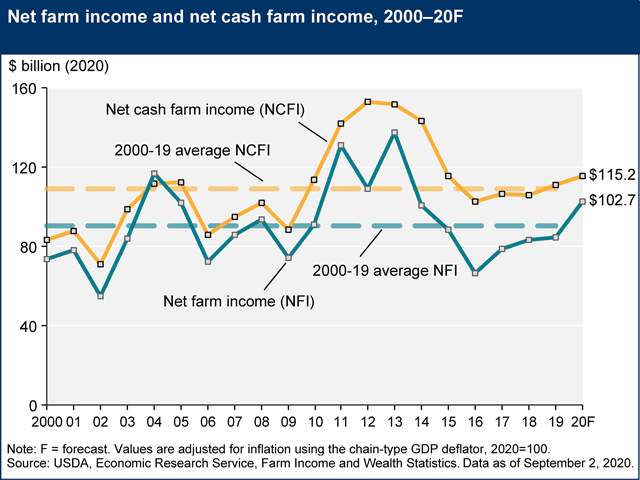Net Farm Income Rising
Government Payments Main Driver of Highest Farm Sector Income in 6 Years
OMAHA (DTN) -- Despite the pandemic, or because of government response to it, the U.S. farm sector is projected to have stronger income for 2020 than a year ago.
The latest projections for U.S. net farm income for 2020 show a nearly 23% increase from 2019 levels due to higher government payments to farmers and lower interest expenses, USDA's Economic Research Service reported Wednesday.
Net farm income, considered a broad measure of profits, is forecast to increase $19 billion in 2020 to reach $102.7 billion. If numbers hold, 2020's net farm income will mark the first time since 2014 that the sector broke the $100-billion mark, climbing out from 2016's low of $66.7 billion.
Looking just at cash receipts for farmers, government payments and subtracting cash expenses, USDA's "net cash farm income" is projected to increase $4.9 billion in 2020 to $115.2 billion for 2020, a 4.5% increase from 2019.
Taking in a broader scope of income and expenses, USDA's "net farm income" factors in cash receipts and government payments minus cash expenses, along with changes in value for farm inventory, depreciation and rental income.
P[L1] D[0x0] M[300x250] OOP[F] ADUNIT[] T[]
A key driver for higher net farm income levels come from higher direct payments to farmers. Beyond crop insurance indemnities, USDA's Commodity Credit Corp., is projected to pay farmers $37.2 billion 2020, an increase of $14.7 billion above 2019 farm subsidies. Those higher numbers come from the supplemental and ad-hoc disaster payments under COVID-19 relief, which is mainly USDA's Coronavirus Food Assistance Program (CFAP).
As of Monday, USDA had paid out $9.4 billion in CFAP payments to producers. Agriculture Secretary Sonny Perdue has said a second round of CFAP will be announced in the near future.
The ERS calculation on government aid also forecast $5.8 billion in aid went to farmers this year under the Paycheck Protection Program, a Small Business Administration loan program set up by Congress. Another $3.8 billion in aid comes from Market Facilitation Program payments that carried over from the 2019 sign up.
Net farm income is rising even though farm cash receipts are expected to fall $12.3 billion, or about 3.3% in 2020. Livestock cash sales are projected to decline $14.3% for the combination of cattle, hogs, broilers and dairy sectors. Cash receipts for chicken broiler sales are projected to fall $6.6 billion (23.4%). Cattle and calves also took a hit with sales dropping $5.1 billion (7.7%). Hog sales are forecast at $3.5 billion (15.9%) lower for 2020 as well. Dairy sales are projected to decline $900 million (2.2%) also.
According to USDA's CFAP payment dashboard, cattle producers have received $4 billion in aid under the program, the most of any commodity. Dairy farmers have received $1.7 billion and hog producers have received more than $582 million under the program. CFAP also provides aid to egg producers, but the program does not provide aid to contract poultry farmers despite requests from the broiler industry in at least a dozen states.
Total crop sales are projected to increase $2 billion, or 1% from last year, reaching $196.6 billion in total value. Those higher crop sales come mainly from fruits and nuts as USDA projects sales for corn to fall $3.1 billion in value, or about 6.2%, from 2019, due mainly to lower prices. Wheat sales will fall $600 million (6.5%); cotton will decline $500 million (7.3%); and soybeans will drop $200 million (.7%) in sale value. Hay receipts will also decline $400 million (5.3%), ERS stated.
USDA projects total production expenses falling $4.6 billion, or about 1.3% in 2020. That stems mainly from lower interest costs for farmers, which are expected to decline $5.6 billion, or 27% from 2019. Livestock and poultry sales declined $2.1 billion in value, or 7.5% for the year.
Still, fertilizer expenses continue to go up, increasing $1.3 billion, or 5.7% for 2020. Farm labor expenses also are going up $1.1 billion in 2020, or about 3.1%.
More details on the ERS farm income projection can be found here: https://www.ers.usda.gov/…
Chris Clayton can be reached at Chris.Clayton@dtn.com
Follow him on Twitter @ChrisClaytonDTN
(c) Copyright 2020 DTN, LLC. All rights reserved.




